
The Foreign Office (FO) on Monday condemned the construction and consecration of ‘Ram Mandir’ on the site of the demolished Babri Mosque in Ayodhya, saying that the temple “will remain a blot on the face of India’s democracy for the times to come”.
India’s Prime Minister Modi inaugurated the temple that embodies the triumph of his muscular Hindu nationalist politics, galvanising loyalists in an unofficial start to his re-election campaign this year.
Modi, in flowing golden-coloured traditional dress, unveiled the black stone idol of the deity Ram in the heart of the 50-metre temple, built on grounds where a mosque stood for centuries before it was torn down in 1992 by Hindu zealots incited by members of his party.
That demolition triggered the worst religious riots since independence — killing 2,000 people, most of them Muslims — and shook the foundations of India’s officially secular political order.
But for Modi’s ruling Bharatiya Janata Party (BJP), the opening of the Ram Mandir temple is a landmark moment in a decades-long campaign to align the country’s governance with its majority faith.
In a statement issued today, the FO said the developments of the last 31 years in India, leading to today’s ceremony, were “indicative of growing majoritarianism in India”.
“These constitute an important facet of the ongoing efforts for social, economic and political marginalisation of the Indian Muslims,” it said.
“A temple built on the site of a demolished mosque will remain a blot on the face of India’s democracy for the times to come. Notably, there is a growing list of mosques, including the Gyanvapi Mosque in Varanasi and Shahi Eidgah Mosque in Mathura, facing similar threats of desecration and destruction,” the FO highlighted.
It added that the rising tide of ‘Hindutva’ ideology in India posed a “serious threat” to religious harmony and regional peace. “The Chief Ministers of two major Indian states, Uttar Pradesh and Madhya Pradesh, are on record as citing the Babri Mosque’s demolition or inauguration of the ‘Ram Temple’ as the first step towards reclaiming parts of Pakistan,” the FO said.
It called on the international community to take cognisance of the “growing Islamophobia, hate speech and hate crimes” in India, urging the United Nations and other international organisations to play their part in “saving Islamic heritage sites in India from extremist groups” and protect the religious and cultural rights of minorities.
“Pakistan urges the government of India to ensure the safety and security of religious minorities, including Muslims and their holy places,” the FO statement concluded.
‘Auspicious’ opening
“The Lord has made me an instrument to represent all the people of India,” Modi said ahead of the “auspicious” opening, as he prayed at the feet of the human-sized statue, garlanded in flowers and draped in jewels.
Outside the temple, tens of thousands of chanting and dancing devotees waving flags, honking horns and beating drums, packed the streets of the northern town of Ayodhya, as military helicopters showered flower petals from the sky.
Few members of Ayodhya’s Muslim community were seen joining the jubilant street party, and opposition leaders are reported to have stayed away.
Vijay Kumar, 18, took four days to reach the town after walking and hitchhiking 600 kilometres.
“We just wanted to be here,” Kumar said. “We just wish to see the temple before we leave.”
About 2,500 musicians are performing on over 100 stages for the crowds of pilgrims around the elaborate temple, built at an estimated $240 million that the project’s backers say was sourced from public donations.
The 140 kilometres between the town and Uttar Pradesh state capital Lucknow is a seemingly endless stream of billboards of blue-skinned Ram with bow and arrow — as well as of Modi and the region’s chief minister, the saffron-robed Hindu monk Yogi Adityanath.
“It’s all because of Modi,” said Prem Sharan, 35, a resident of Ayodhya.
“Some critics say that it is being turned into an election-like atmosphere; so be it. At least they are doing what they promised and one needs the power to do things for the people.”
Other attendees jetted into the newly built international airport and will stay at a crop of hotels built to cater to the millions of pilgrims expected to visit each year.
Among the celebrity guests due at the opening were Indian tycoons, former national cricket captain Virat Kohli and Bollywood titan Amitabh Bachchan.
Tight security rings India’s Ayodhya temple amid violence fears

NEW DELHI: Tight security has been clamped on Ayodhya town where a new temple will be inaugurated with state-sponsored fanfare by Prime Minister Narendra Modi on Monday.
The star-studded event is expected to draw popular movie actors, cricketers and leading industrialists to the temple town. A newly commissioned airport in Ayodhya would assist.
Muslim residents of the erstwhile multicultural hub, however, say they have sent their children and women to relatives in neighbouring towns, fearing violence.
On Dec 6, 1992, a Hindu mob had razed the 16th century Babri Masjid in Ayodhya, claiming that Muslims had built it over the place of an ancient temple. The mosque destruction is celebrated as a day victory by Hindutva supporters, while for Muslims, it was a day of terror.
Modi to inaugurate temple today as Muslims seek security
Among those invited to the inauguration, stars Amitabh Bachchan, Alia Bhat, Ranbir Kapoor, Rajnikanth, Kangana Ranaut, Madhuri Dixit, Akshay Kumar, Anushka Sharma and cricketer husband Virat Kohli feature prominently.
The guest list also includes President Droupadi Murmu, Vice President Jagdeep Dhankhar, BJP stalwarts Murli Manohar Joshi, L.K. Advani, former prime minister Manmohan Singh. It is not clear if all would travel.
Congress leaders including Mallikarjun Kharge and Sonia Gandhi were also invited, but they have declined to attend the event. Some of the most senior religious leaders of Hindu sects are boycotting the event.
Sachin Tendulkar, chess grandmaster Viswanathan Anand, Sunil Gavaskar, Mahendra Singh Dhoni, Sourav Ganguly, Anil Kumble, Virendra Sehwag and Indian cricket coach Rahul Dravid are invited. Actors Arun Govil and Dipika Chikhlia, who portrayed Ram and Sita in Ramanand Sagar’s popular TV series “Ramayan”, are on the list as are singer Malini Awasthi, sarod maestro Amjad Ali Khan.
Among the industrialists, billionaire Mukesh Ambani and his family, Ratan N. Tata, Gautam Adani, and Nusli Wadia of Bombay Dyeing, grandson of Quaid-i-Azam, are invited.
Paramilitary troops protecting the main temple to cordon off the sanctum sanctorum. The central force has been guarding the Ramjanmbhoomi since the late 1990s. Special state forces have the largest component, with 1,400 personnel from UP Police and PAC that will be deployed in the ‘red’ zone just outside the temple. Artificial intelligence, drones and CCTVs are being used as an added layer of security.
A local Muslim organisation submitted a petition to local authorities demanding strict security and vigil in localities with sizeable Muslim populations as well as other parts of Ayodhya which witnessed the demolition of Babri Masjid and communal violence in 1992.
In an interview with the Newslaundry portal, Arshad Madani, president of the Deoband Muslim seminary, expressed similar fears, and said he wanted Hindus and Muslims to live in amity. Muslims living in Ayodhya town say they are worried despite the Uttar Pradesh government’s repeated assurance that it would maintain peace and security in the area on the date of the consecration ceremony and afterwards, despite a likely influx of devotees.
Petitioners spoke of the past when Hindus and Muslims lived in peace in the town abutting Faizabad, the old capital of Oudh, until the 1990s. “In Ayodhya town, Hindus and Muslims have lived in peace, but in the past, due to mobs of outsiders at various events, the Muslim community has suffered loss of life, property and religious places,” stated Muslims’ petition to the police.
“From January 22, after inauguration of the Ram Temple, it is estimated that a large crowd of outsiders are slated to visit, hence Muslims residing in Ayodhya town are fearful of life, property and religious places. In view of previous experiences, we request for strict vigil and security in localities like Terhi Bazar, beside Teen-wali-Masjid, Gol Chauraha Sayyadbara, Begumpura, Durahi Kuan, Mughalpura, among others,” read a January 16 letter by the Anjuman Mohafiz Masjid-wa-Maqabir, an organisation of local Muslims, addressed to the Inspector General of police, Ayodhya division
In Ayodhya district, 14.8 per cent of the nearly 2.5 million inhabitants are Muslims, The Hindu said. There are roughly 5,000 Muslims in a four-kilometre radius around the temple.
“Some Muslims have sent their children and women family members to relatives’ homes in Lucknow, Barabanki or other nearby districts. We tried to convince them as administration guaranteed security, but the fear of 1990 and 1992 communal incidents is difficult to forget for many people,” said Mohammad Azam Qadri, president of the Sunni Central Waqf Board sub-committee in Ayodhya.
“Hundreds of thousands of men were all over Ayodhya. They had sticks, swords and tridents. Our house was surrounded by them,” Anwari Begum, now 65, recalled the destruction of the mosque while talking to BBC.
“We ran from our homes. I ran with my six-month-old baby and small children. My husband was running behind us. When I turned, I saw that he had been caught by some men. We had to keep running for our lives,” she said.
The next day she found out her husband, Mohammad Amin, had been killed, one of at least 17 Muslims who died in shocking violence in Ayodhya that day.
Meanwhile, the court rejected the appeal by the 11 convicted rapists of a Muslim woman, who were given premature release from jail, to delay their return to prison. They are expected to be in jail on Sunday, a day before the grand event in Ayodhya being staged by those that set them free.
Published in Dawn, January 22nd, 2024
An affront to Gandhi’s Ram

IT was a day to celebrate and cheer for the ruling party. It was a day to reflect and worry for India’s future. It was a day for the BJP to show what many say is its trump card in the run-up to the general elections due in May.
According to this view, the grand but all too rushed inauguration of the Ram temple in Ayodhya was aimed at securing votes, like the way the killing of security personnel in Pulwama did in 2019, or as the politically induced communal carnage in Muzaffarnagar was used in 2014.
It was a day for the opposition to calibrate its response, quietly, a day when Rahul Gandhi battled obstacles in the BJP-ruled Assam in his east-to-west march for unity and justice. It was a day when Mamata Banerjee offered puja at a Durga temple in Kolkata to call for a needed campaign for communal unity. It was the day when several key opposition leaders politely turned down the invitation to visit Ayodhya.
It stands to reason that the most critical foil to the BJP’s religious-nationalist card in the coming elections is INDIA itself, the alliance that powerful regional satraps knit together with the resolve to defeat Prime Minister Modi with a decisive headcount. The opposition is not unaware that National Socialists had 37 per cent votes when Hitler came to power, almost exactly the count that the BJP got in 2019. But one doesn’t have to be irrational about these things.
There’s a difference between the Nazis of Germany and the current strength of Hindutva forces in India. Hitler didn’t hold elections after coming to power. That possibility doesn’t exist in India for the near future. It’s a defining difference, and it’s one the opposition plans to seize with everything it has. It must shepherd the remaining 63pc voters into a fighting unit
There’s nothing to indicate that the premature and apparently desperate inauguration of the Ram temple would stand in the way of an opposition bid to win the 2024 polls. If the BJP hopes to exploit a daylong spectacle in Ayodhya to canvass support in the name of the new temple to Ram, that shouldn’t worry the opposition at all, provided peace prevails. Do note that the last two Lok Sabha polls were fought with the BJP foregrounding divisive violence, domestic in 2014, and cross-border in 2019.
The opposition needs a plan to counter any scope for communal friction, which many see as a possibility if the temple ploy falters. This is one of two main challenges the INDIA alliance needs to have a plan to thwart.
The other is a questionable presidential tradition. Since the opposition is gearing to fight the election as an alliance and not as a single unit, there is a real chance of a technical glitch.
Should the BJP emerge as the single largest party but without a clear majority, the president, would be technically correct to invite Mr Modi to form the government. And we know only too well how wrecking opposition parties has been honed into a craft by Mr Modi. Money would not be a problem looking at the list of the moneybags at the Ayodhya event.
There is a tradition, shown by Rajiv Gandhi, for example, who preferred to sit in the opposition in 1989, despite heading the largest party albeit without a majority. And there is the example of Atal Bihari Vajpayee in 1996. Asked first, he jumped at the opportunity to be prime minister for all of 13 days. Those are the truly daunting challenges the opposition faces, not the Ayodhya event.
If the BJP hopes to exploit a daylong spectacle in Ayodhya to canvass support, that shouldn’t worry the opposition at all, provided peace prevails.
We don’t know, of course, how the date of Jan 22 was arrived at for the temple inauguration by Mr Modi, but it surely meant different things to different people.
According to a TV interview by one of four Shankaracharyas that head the Hindu fold of Sanatan Dharma, a particular astrologer from Varanasi was pressed to find an auspicious day in January even though the temple was not complete and is not likely to be for quite a few more months. The idol ceremony requires the temple to be complete, the Shankaracharyas have pointed out. To what avail?
There was a gamut of things happening on Jan 22 in the wider world.
An EU delegation was heading to the Middle East. Ron DeSantis quit the US presidential race as Republican hopeful to throw his weight behind Donald Trump. For the Palestinians, particularly those in Gaza, it was another day of trauma, ironically at the hands of those who were themselves victims of unconscionable brutality, but in Europe. It was a dreary day also in the uprooted lives of the victims of an unending war between Russia and Ukraine.
It was also a day when all 11 convicted rapists of a Muslim woman in the Gujarat pogroms were back in prison. They surrendered together at 11.45 pm on Sunday, reports say, to comply with the supreme court’s refusal to extend their premature release by the BJP establishment.
The apex court shot down the reprieve albeit on technical grounds. It must have been a sombre day for Bilkis Bano who, though she saw her tormentors jailed again by the kindly judges, must have sensed an entire culture of sectarianism and hate uncorked in Gujarat in 2002 now seeking divine blessings in Ayodhya.
Religion is a peculiar thing. Mahatma Gandhi was an ardent devotee of Ram, and his killer’s name was Nathuram, literally Lord Ram. It’s not unusual for this to happen. Zealots of any faith pounce on their own quite readily.
But Gandhiji’s Ram, as depicted in his favourite bhajan, was a defender of the weak and the fallen. Ishwar and Allah were harmoniously enshrined in his telling of Ram, something negated by the divisive construct of a new cult Mr Modi may have unveiled in Ayodhya.
The writer is Dawn’s correspondent in Delhi.
jawednaqvi@gmail.com
Published in Dawn, January 23rd, 2024
Ram Mandir — an ill portent

A staggering $4.2 billion have been collected as donations, both official and private. Though the temple’s completion is years away, consecration ceremonies began days ago. RSS has distributed 50 million small food packets and the first seven tonnes of halwa have arrived.
The government is arranging train and helicopter services for 100,000 sadhus and devotees, contracts for new five-star hotels have been awarded, and schools are holding daily prayers. Muslims have been advised to limit their travel by bus and train.
On Monday, Prime Minister Narendra Modi will arrive in Ayodhya. His recent message: “The whole world is waiting for the historic moment. With folded hands, I am requesting 140 crore people of the country that on Jan 22, when the consecration of Ramlalla’s idol takes place, light the Ram Jyoti in your house and celebrate Deepawali.” Hospitals in Uttar Pradesh report that dozens of pregnant women have requested C-sections so their child is born on this auspicious date.
The purpose of these celebrations — and the PM’s lead role — is ostensibly religious, but some senior priests dispute that. They will boycott the event because Modi is technically unqualified for performing the ‘pran-pratishtha’ (putting soul inside an idol) ritual. This scarcely matters, because Modi wants to signal once again that under him a new India has arrived, one bearing little or no resemblance to the India born in 1947.
Hindutva’s message targets two audiences. The first is India’s Muslims: reincarnated India is for Hindus, not for them. Just as Pakistan treats its Hindu population as inferior citizens with fewer rights, so too Muslims in India must never forget they are the unwanted progeny of invaders who despoiled a pristine land and robbed it of its glories.
Religious communalism in reincarnated India is no longer considered abhorrent.
Revenge — exemplified by destroying ancient structures — is Hindutva’s guiding principle. In March 2023, when a mob shouting ‘Jai Shri Ram’ burned down a century-old madressah and library containing ancient manuscripts, it was tit-for-tat for the sacking of Nalanda University by the 12th-century Muslim invader, Bakhtiyar Khilji. To avoid adverse consequences during the Ram Mandir consecration, RSS has recommended that Muslims chant “Shri Ram, Jai Ram, Jai Jai Ram” in mosques, dargahs and madressahs.
The second message is to BJP’s political opposition, principally Congress. Change your discourse from secular to religious and play on our turf. Else, be seen as anti-Hindu and lose out in the April 2024 elections, when Modi will seek his third term.
Ram Mandir’s inauguration has left Congress dazed. Just days earlier, its top leaders had scorned this ‘political event’ and refused to attend. But those below could not take the pressure and broke rank. They visited Ayodhya, took a holy dip in the river, and vowed they too want “Ram Rajya” — albeit a better one than BJP’s.
Mixing religion with politics — whether in the Hindu or Muslim way — won’t surprise those who know Pakistan’s history. Soon after the All India Muslim League suffered a crushing defeat in the 1937 elections, its leadership successfully weaponised religion and wove it into politics. It was reinjected with a double dose by Gen Ziaul Haq in the 1980s.
Today, in every Pakistani political party’s arsenal, religion is the weapon of choice for demolishing opponents. When in power, PTI used it repeatedly against PML-N and PPP. In retaliation, Maryam Nawaz’s media team has recently returned the favour — with markup — in attacking Imran Khan.
Still, to me, an infrequent visitor to India, secularism’s rapid retreat comes as a surprise. Twenty years ago, while visiting the Jawaharlal Nehru Institute for Advanced Research in Bangalore, I was intrigued by Nehru’s words inscribed on the foundation stone: “I too have worshipped at the shrine of science.” But I don’t see ‘worship’ and ‘shrine’ tallying well with modern science or the scientific temper associated with Nehru.
My hosts rushed to explain. Shrine of science, they said, was actually a metaphorical allusion to labs and research centres. Nehru, they proudly asserted, was an atheist and never went to temples. Later, I found he actually did visit temples as well as mosques. Further, as in his prison diary The Discovery of India, his view of religion is fairly nuanced.
Mani Shankar Aiyar recently argued that Nehru would have fought tooth and nail against making Hinduism India’s official religion. In December 1947, his cabinet decided to rebuild — at state expense — the Somnath temple plundered in the 11th century by Mahmud Ghazni. When Nehru found out, he was furious and had the minutes secretly altered. But so long as the state was not involved, he said, any private initiative was fine. In 1951, when president Rajendra Prasad sought to officially visit the restored temple, Nehru refused permission.
India’s other founder, Mahatma Gandhi, would also have roundly rejected making the grand new Ayodhya temple. Ramachandra Guha, his biographer, notes that whereas Gandhi called himself a devout Hindu, yet in the many years he lived in Ahmedabad, he did not visit any of the city’s temples. Why, said Gandhi, does God need a building or idol to be worshipped?
Gandhi’s eclecticism is evident from his prayer meeting of Nov 21, 1947: “As per the information I have received, about 137 mosques of Delhi have been virtually destroyed in the recent riots. Some of them have been turned into temples. In my opinion, this goes against every tenet of religion … The magnitude of this act cannot be mitigated by saying that Muslims in Pakistan have also despoiled Hindu temples or turned them into mosques.”
India’s descent into a Hindu rashtra generates a kind of smug satisfaction in Pakistan, a vindication of the two-nation theory that Hindus and Muslims cannot ever live together. But then, how shall the Muslims of India, and the few Hindus remaining in Pakistan, fare in times to come? Whether India can ever revert to its earlier, more accommodative and secular self, is an open question. For Pakistan, whose flirtation with liberal values ended in the 1970s, it appears even more difficult.
The writer is an Islamabad-based physicist and writer.
Published in Dawn, January 20th, 2024
Contrasting Consecrations at Somnath and Ayodhya Rama Temple
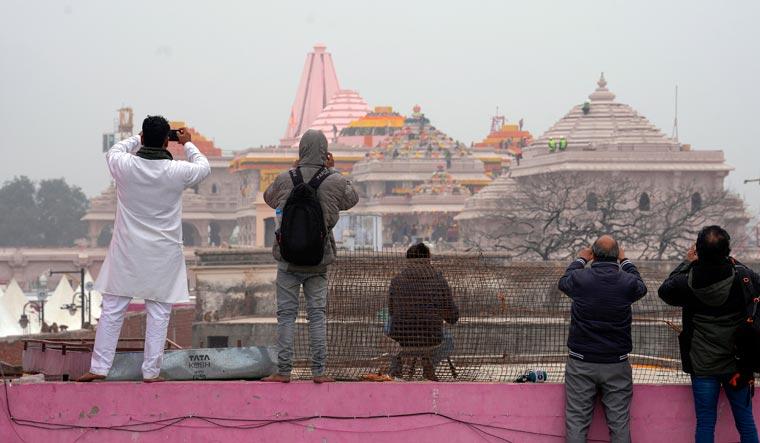
The restoration of the Somnath temple initiated by Sardar Vallavavai Patel by mobilising money from the public and its consecration in 1951 offers vital lessons regarding the consecration of the Rama temple in Ayodhya.
Patel heeded Mahatma Gandhi’s pleadings that government funds should not be used for a shrine representing any one faith. It was Gandhi’s conviction that the Indian State should always maintain neutrality towards religion, a sentiment he expressed in the context of the restoration of the Somnath temple while addressing a prayer meeting in Delhi on 28 November 1947.
He said the government formed after independence represented all Indians pursuing diverse faiths because, in his own words, “It is a secular government, that is, it is not a theocratic government. It does not belong to any particular religion.”
Nehru Disapproved of President’s Participation in Somnath Event
Then President of India, Rajendra Prasad, was invited to participate in the consecration ceremony of the Somnath temple and inaugurate it on 11 May 1951. He sought the views of Prime Minister Jawaharlal Nehru, who, on multiple occasions, requested him not to do so since, as the head of the Republic, he represented the secular State of India. Therefore, his participation in consecrating the Somnath temple would go against the secular nature of governance.
Nehru Felt Somnath Event was Political
Nineteen days before the consecration of the Somnath temple, Nehru wrote to Prasad (on 22 April 1951) expressing his worry about the Somnath affair. He stated, “As I feared, it is assuming a certain political importance.” Proceeding further, he added that at the international level, references were being made to it and remarked, “In criticism of our policy in regard to it, we are asked how a secular government such as ours can associate itself with such a ceremony which is, in addition, revivalist in character.”
Nehru also informed Prasad that in response to several questions in Parliament on the issue, he had stated that the government had nothing to do with it and those connected with it were acting in their personal capacity.
Nehru’s remarks from 73 years ago resonate in the context of the consecration of Ayodhya’s Rama Temple. It has been built on the spot where the Babri mosque once stood and was demolished. The Supreme Court, while allowing the construction of the temple, held that the demolition constituted “an egregious violation of [the] rule of law”. Prime Minister Narendra Modi and several other constitutional functionaries are participating in the inauguration, which also makes it a political event.
Nehru Declined Somnath Event Invitation
When on 22 April 1951, Digvijay Singh, the Rajpramukh or head of the government of Saurashtra, invited Nehru to participate in the consecration ceremony, he wrote on 24 April thanking him, and stating with sadness, “I am troubled by this revivalism and by the fact that our President and some ministers and you as Rajpramukh are associated with it.”
“I think,” Nehru wrote, “That this is not in line with the nature of our State, and it will have bad consequences both nationally and internationally.” “As individuals, of course, it is open to anyone to do what he chooses in such matters... But many of us happen to be more than private individuals, and we cannot dissociate ourselves from our public capacities.”
Pride Over Rama Temple Invite
How the Prime Minister and his party are taking obvious pride in being invited to inaugurate the Rama temple in Ayodhya amidst a spectacle of priestly rituals sharply contrasts the ideals of a secular State and Nehru’s vision.
In a letter written on 28 April 1951 to RR Diwakar [former Information and Broadcasting minister in the Nehru Cabinet and later the Governor of Bihar], Nehru described the Somnath consecration event as a “pompous ceremony” and asserted that “...any kind of governmental association is going to injure us abroad and even in India”. He revealed that he had received many complaints and letters inquiring “...if this is how a secular State behaves”.
Nehru wrote with anguish that the Rajpramukh of Sourashtra directly wrote to Indian embassies abroad to send soil from those countries and water from some important rivers to reconstruct the Somnath temple. He stated that such requests greatly embarrassed the country, and foreign missions and leaders of many countries were wondering why a place of worship being restored in India would use foreign soil and water.
Other Leaders Disapproved of President’s Decision
It has been a persistently popular notion in India that only Nehru disapproved of President Rajendra Prasad’s decision to participate in the Somnath consecration ceremony. A peep into the records of that period and numerous other writings of Nehru reveals that several distinguished leaders and public figures expressed solidarity with him and made persuasive appeals to Prasad not to associate himself with the Somnath shrine ceremony. For instance, S Radhakrishnan, acclaimed for his deep understanding of Indian and Western philosophy, wrote that the association of high functionaries of the State with the consecration of Somnath temple was “liable to misunderstanding”. Even C Rajagopalachari joined hands with Nehru to dissuade President Prasad not to participate in the Somnath programme. Mridula Sarabhai, sister of the renowned space scientist Vikram Sarabhai and a freedom fighter, also supported Nehru’s stand on the Somnath issue. Nehru advised Sarabhai to meet Prasad and share her critical stand.
Contrasting Publicity for Somnath and Rama Temples
The unabashed media publicity given to the Rama temple event in Ayodhya by the corporate-controlled TV channels and many print outlets is at the cost of the fundamental issues of the people. It reminds of Nehru’s statements on 28 April 1951 regarding his instructions to the media on their coverage of the Somnath temple consecration. He wrote, “I feel that in the circumstances, our radio broadcast should rather tone down the description of what happens at Somnath and not make it appear in any way that it is a governmental function.”
However, we now witness the Modi regime giving no-holds-barred publicity to the Rama temple consecration event.
Stress on Secular Non-communal Ideals
In a letter to chief ministers on 2 May 1951, nine days before the Somnath ceremony, Nehru wrote that several people were attracted to it, and some of his colleagues preferred to participate in the event in their personal capacities. While doing so, Nehru wrote, there was bound to be “a certain measure of public support to this venture” and cautioned that nothing should be done to come “in the way of our State being secular”.
He flagged the point that secularism formed the very basis of the Indian Constitution and governments and urged chief ministers to “refrain from associating themselves with anything which tends to affect the secular character of our State”. “There are, unfortunately”, Nehru said, “many communal tendencies at work in India today, and we have to be on our guard against them.” He also said, “It is important that governments should keep the secular and non-communal ideal always before them.”
Tragically, secular and non-communal ideals are being relentlessly devalued by the powers that be. They have pushed the country into a whirlpool of politics anchored in rituals and divisive religious narratives, contrary to the Constitution and its vision of India that celebrates the coexistence of all faiths.
Tuning into the vision of Gandhi and Nehru to salvage the secular State is a vital lesson which Indians today ignore at their peril even as they witness the ritually driven consecration ceremony at Ayodhya with the active involvement of the Prime Minister.
The author served as an Officer on Special Duty to the President of India, KR Narayanan. The views are personal
Ayodhya: All Eyes Skyward at Grand Temple; Shopkeepers Left With Rubble Below
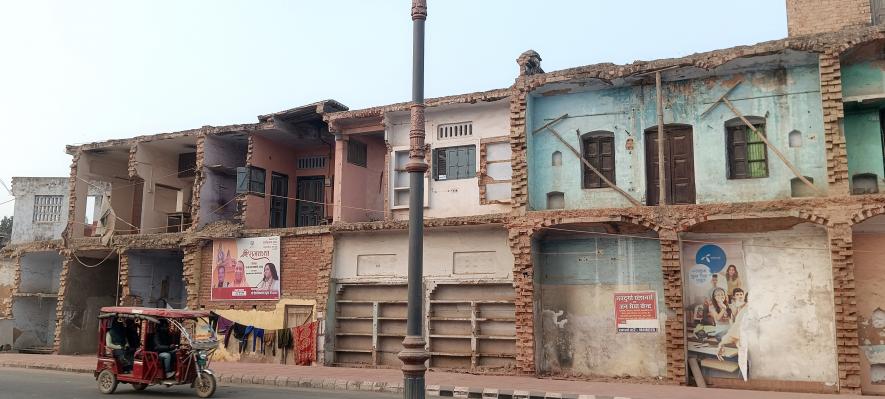
Ayodhya: Moving towards Ram Path Marg, the arterial road leading to the Ram Temple, one can see demolished old houses and shops on both sides of the road. Hidden behind the cutouts featuring Prime Minister Narendra Modi and Lord Ram, several shopkeepers and families say they have lost their daily earnings after their roadside shops and houses were demolished by the authorities because of the road widening project.
Amid preparation for the Ram temple consecration ceremony in Ayodhya on January 22, shops witnessed a beeline of devotees in huge unprecedented numbers, the shopkeepers said. However, a feeling of anxiety is visible on Neeraj’s face while he negotiates with a customer.
Neeraj Singh (27) sold a portrait of Lord Ram worth Rs 250 to the customer for Rs 155 because the customer had that much money.
“We have been selling pooja items for four generations here at Ram Path. Thirty feet of my house was demolished during land acquisition for the road widening project. A compensation of Rs 2.85 lakh only was given to us even though the circle rate has gone up by more than 10 times since the verdict for building a Ram temple was announced by the Supreme Court in 2019. We should have been given at least Rs 17 lakh at the current circle rate to be fair. Building the Ram Temple will only be beneficial for us shopkeepers if our business runs successfully,” Singh told NewsClick.
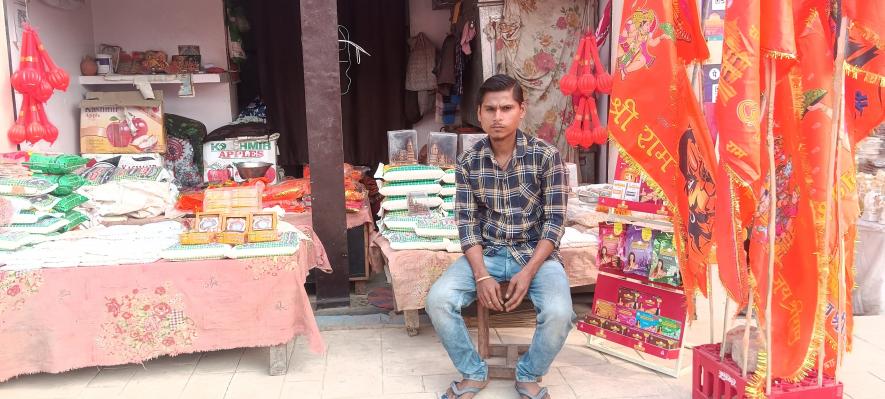
There are half-broken shops on the 13-km stretch of what is now called Ram Path—many run for generations by the same family. Shop owners have two complaints: firstly, the compensation given to them was far below the prevailing market rate and secondly, they worry about having to repay the loans they have taken from their relatives to extend the shops after demolition. While the compensation stands at six times the circle rate, after the Supreme Court of India’s verdict on the Ram Janmbhoomi Title suit in 2019, the market rate has gone up by more than 10 times the circle rate.
‘Govt Bulldozed Our Livelihoods, Hopes’
Over 1100 shops and houses have been demolished on the 13-km stretch on Ram Path. Ravi Chetrpal, who runs a bakery shop barely 70 meters from Hanuman Temple, has given up more than 90% of his shop for the project. “I had a 25-foot shop, of which 20 feet was demolished by the authorities. I received only Rs 1 lakh as compensation from the government. Unable to operate a shop within the remaining five feet, I paid Rs 10 lakh as pagadi (advance money) to extend my shop by 10 feet to the Hanuman Garhi Trust,” he claimed.
The Hanuman Garhi Trust owns most of the shops in the temple’s vicinity.
Ravi, a native of Ayodhya, was upset about how he would return the money he had borrowed from his relatives and friends.
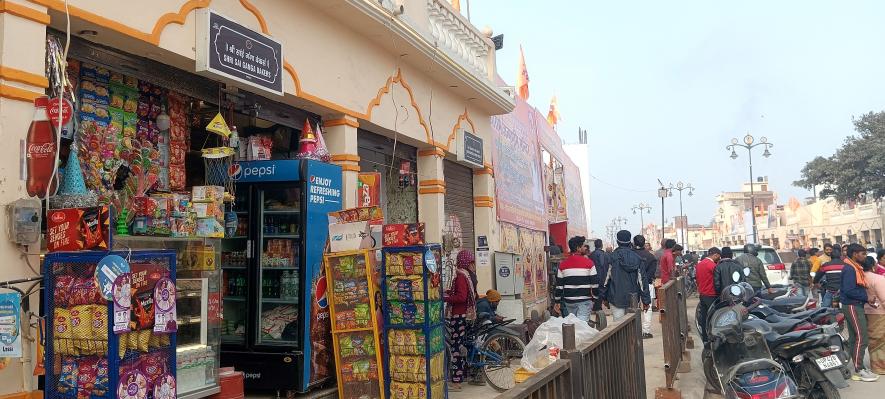
“I have been given Rs 1 lakh compensation from the government and I had to pay Rs 10 lakh to expand the shop. What did we gain?” he questioned.
This isn't just Ravi's story; all the shopkeepers along Ram Path share a similar narrative, expressing dissatisfaction with the lack of fair compensation.
The narrow road leading to Hanuman Garhi, dotted by shops on both sides, is now around 14 metres wide. Shops have been half-demolished to pave the way for the 800-metre Bhakti Path. The sound of the ringing of temple bells and conch shells echoes in the air. However, its juxtaposition to the rubble and lacklustre faces of those who are dealing with the aftermath of the demolition is striking.
“It was everyone's dream that Ram Temple should built, but at the cost of demolishing our houses? Even God himself would not want this. Where should we go with the broken houses and shattered dreams?” asked Divya, with her voice choking and tears rolling down her face.
Raghaw Saini, a utensils seller, said three of his four shops were demolished as the administration tried to widen the road leading to the temple and his sales have come down heavily because of losing these locations.
“We were paid Rs 20 lakh compensation for both the shops, but the Hanuman Garhi trust, which allocates lands, is now demanding Rs 22 lakh for allotting us a single shop in another location which we cannot afford. Most others cannot afford it as we are hand-to-mouth people,” Saini told NewsClick.
The serpentine lanes of Ayodhya today have been engulfed in the loud noise of machinery and earthmovers, symbolising the ongoing transformation of an ancient city into a sprawling modern pilgrimage center.
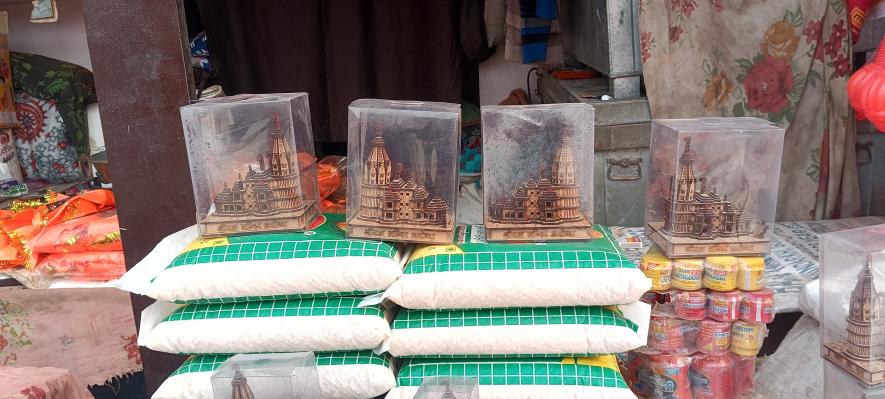
Mohan Provision Store, situated next to the Post Office Tiraha, is regarded as the largest ration shop in the city. Recently, it relocated away from the main market. Ajay Maheshwari, the current proprietor, said that this shop has been operated by his family for three generations, spanning approximately 80 years. The compensation received for the shop is significantly below its assessed value. Despite this, in an effort to preserve his ancestral business, he was compelled to open a shop on the street adjacent to the police station.
Trivedi Library, right in front of the Kotwali, was a famous shop for religious books in the city. Its owner Nand Kishore Trivedi says that the entire shop was gone in one stroke. Under compulsion, he is running his business in a rented shop in Rani Bazaar. He said that many people used to come to his shop from outside the town; now, it would not be possible to give the address of the new shop to everyone.
Mangal and Gayatri Medical Stores were located opposite each other near the Ayodhya Hanumangarhi intersection, both now operating their businesses from their homes. Deep Narayan Gupta, the proprietor of Mangal Medical Store, is currently grappling with depression following the demolition of his decade-old house. Gupta said he purchased the shop about 15 years ago in very difficult circumstances, and it has now been lost in a flash. Lacking the courage to buy another one, he is compelled to earn his living by opening a shop in his house on a street near Tedhi Bazaar.
“We are not against the construction of the temple, but we should have been given sufficient compensation so that our businesses don’t suffer. But who cares for the poor when the whole country is singularly focused on Ram? I hope Lord Ram gives wisdom to the government to understand the pain felt by poor people seeing their houses being demolished,” Sugriv, a local, told NewsClick.
NewsClick visited several shopkeepers, most of whom were originally situated on the front road near the temple premises. Following the demolition, these shops were relocated to narrow lanes, making it a challenging task for any customer to reach them.
However, the businessmen also hold hope for the Ram Mandir, anticipating that business will flourish rapidly once it opens for devotees.
Ayodhya: As Ram Temple Mega Event Nears, not a Single Brick Laid on Land Meant for ‘Grand Mosque’
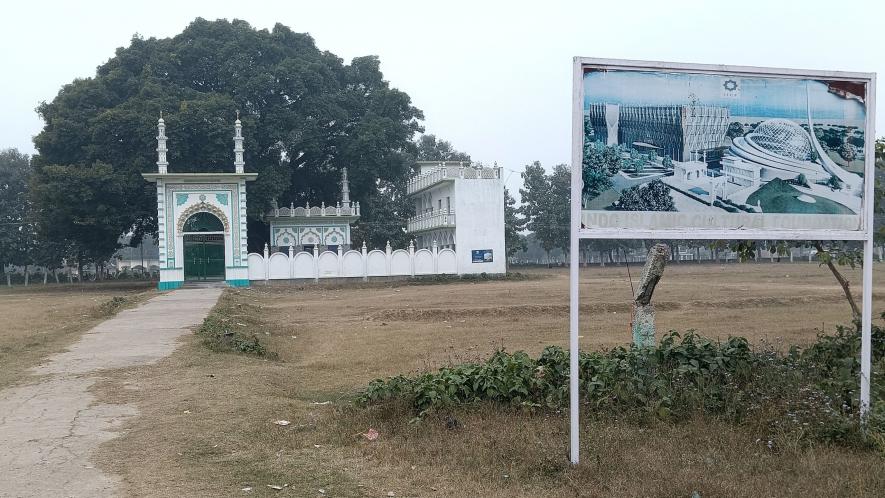
Dhannipur (Ayodhya): It was 10:30 in the morning. A dense fog enveloped Masjid Mohammad Bin Abdullah, the proposed mosque in Dhannipur village. At first sight, goats and other livestock could be seen grazing on the vacant plot in the village.
Ignoring the chilly winter morning, children could be seen playing cricket on the land, unaware of the place that made international headlines over four years ago when it was officially allocated by the Supreme Court for construction of a mosque.
The alternate piece of land, located at Dhannipur village, is barely 20 km from the disputed 2.77 acres, where the historic Babri Masjid once stood before being demolished on December 6, 1992.
The villagers are still waiting for some activity on the vacant plot meant for the ‘grand mosque’ project, a law college, a 500-bed cancer hospital, a community kitchen that would feed about 1,000 poor people daily free of cost and other amenities.
However, the local residents of Dhannipur and Raunahi, Muslim majority villages, seem to have other plans than a ‘grand mosque’. They feel they urgently need a hospital, a government college and other government institutions more than a ‘grand mosque’.
"Every day, four-five people including politicians, religious scholars and journalists from across the country visit Dhannipur ever since this land was allocated for a mosque. Everyone promises that a ‘grand mosque’ along with a hospital, a college and community kitchen will be constructed. The villagers were ecstatic that the region's fortunes would change. But it has been over four years, but not a single brick has been laid here. God only knows when all this will come true," Mohd Sajid Khan, whose goats were grazing on the premises of the proposed mosque, told NewsClick.
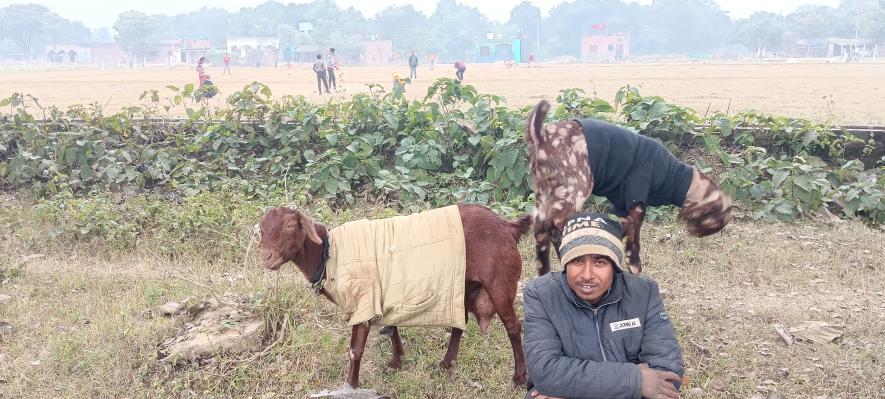
Khan, who studied till Class 12, regretted not going for higher education as there was no government college in the area.
"What we need urgently is a government hospital and degree college more than a mosque. There are already 20 mosques in Dhannipur and Raunahi villages. In the absence of a hospital, we are forced to go to Lucknow or Faizabad for treatment,” a dismayed Sajid said.
Following the long-fought Babri Masjid-Ram Janmabhoomi title suit, the apex court in its 1,045-page judgment had ordered, in November 2019, the state government to allot 5 acres to the Uttar Pradesh Sunni Central Waqf Board for the construction of the proposed mosque, Masjid-e-Ayodhya, which is now called Masjid Mohammad Bin Abdullah at the alternative land. It is now under the supervision of the Indo Islamic Cultural Foundation (IICF) — a trust set up by the Waqf Board.
"The Babri Masjid verdict never said there was a Hindu temple before the Masjid, they just gave that land because the executive, judiciary, legislation is all dominated by majority. If there were neutral courts, the land would have been given to Muslims with compensation, and the criminals would have been sent to prison," Sohail Ismaili, who is disappointed that a grand mosque would never be constructed in his village, told NewsClick.
Ismaili, a religious scholar, argued that there was no point taking land in charity when you have “captured Babri Masjid.”
“A grand temple is being built at a distance of 20km in the same district and not even a single brick foundation has been laid here in four years. Aren’t Muslims being considered second class citizen in our own country. We do not have any hope in any institution,” said Ismali, who was sitting along with his friends around a bonfire to warm themselves in Raunahi village, facing the proposed mosque site.
Raunahi and Dhannipur villages are opposite each other. There is a distance of only 20 feet road. Both the villages have a Muslim majority population. The adjacent villages Chirra and Magali are also Muslim-dominated. One thing is common to all these villages is lack of education, infrastructure, unemployment.
‘LOST HOPE’
Barely 20 km from Dhannipur, preparations for the much-anticipated consecration of the Ram Mandir are in full swing in Ayodhya on January 22. Alongside, a lost hope for building a mosque, cancer hospital, college and community kitchen pervades these villages.
Majid Khan (24), who recently completed his Masters from Rammanohar Lohia Avadh University, Ayodhya, and is preparing for CAT exam, lives 100 meters from mosque area.
"Apart from the mosque, a hospital, a college and kitchen were proposed for the benefit of every community. The government has given a huge amount to build the Ram temple in Ayodhya, making every possible effort to give it an international platform. Soon tourists will throng and that will create revenue. Had the government allocated some funds for our village, at least a hospital and college could have been built. But, we (Muslims) are not on government’s priority,” Majid told NewsClick.
Another villager, Shiv Narayan Maurya, a staunch Bhartiya Janata Party (BJP) supporter, was all set to welcome Lord Ram at his home on January 22. Though he was very happy after a decade of judicial proceedings that he could visit Ayodhya to catch a glimpse of Ram’s idol, he said the saffron government should refrain from dragging Mathura and Kashi, as the state’s ‘Ganga-Jamuni tehzeeb’ must not get eroded. Maurya also said that he was ‘disappointed’ that even after four years, the land allocated for the mosque still wore a deserted look.
“I don’t know the reason behind the delay behind the mosque but some concrete work should have been done in four years. We have been waiting for a long time for a hospital and community kitchen,” he said.
A little farther away, a group of villagers at a tea shop could be heard discussing the same topic – on why the mosque was being delayed. They felt it was because of shortage of funds.
“Many old people died dreaming of seeing a ‘grand mosque’ in Dhannipur. We have been hearing that the committee does not have funds for the mosque,” one villager told NewsClick.
Sohrab Khan, a local journalist, told NewsClick, “Masjid Mohammad Bin Abdullah will be a centre of ‘dawa-dua’ as it will not only allow people to offer namaz but also house a 500-bed cancer hospital, which will benefit people. No one from UP will go to Delhi or Lucknow for cancer treatment. Our village is crying for attention. But who cares…. (religious) identity does matters in today’s political scenario.”
COMMITTEE FACES FUND CRUNCH
In 2019, the Indo Islamic Cultural Foundation was formed, after the Supreme Court mandated the construction of a Ram temple at a disputed site in Ayodhya. As per last year’s circle rate, Rs 3 crore were needed, which had to be given to Ayodhya Development Authority (ADA), but could not be paid due to lack of funds. Similarly, a huge amount was also required to be paid for the approval for building maps and NOCs (no-objection certificates) from civic authorities, the UP Pollution Control Board and fire services.
“It is not possible to construct a grand mosque along with community kitchen, cancer hospital and degree college on five acres. The Indo Islamic Cultural Foundation is in the process to purchase six acres additional land from farmers. This needs a huge amount. People will donate, if the committee advertises, like mandir committee did with the help of government,” the journalist said.
He said, “On one hand, people have been donating for the construction of the temple for more than 20 years and the government is also helping out, on the other, only three years have passed since the Indo Islamic Committee was formed, but there is no money. Where will so much money come from? People are not even aware of how to donate.”
NewsClick also spoke to Athar Hussain, secretary, Indo Islamic Cultural Foundation. He said, “The judgement came on November 9, 2019. It was the justifiable suit settled by honourable Supreme Court that the then premises of Babri Masjid would be given to the trust which will build the Ram Mandir. The claim of Muslim parties on the land was rejected. Within that the judgement, the SC gave 5 acres to the UP Sunni Central Waqf Board for building the mosque. The Waqf Board constituted Indo Islamic Cultural Foundation, which was given possession of the land by the district administration of Ayodhya in September 2020. It has been three years since the possession of land. After that we went to Dhannipur and Raunahi for deliberation on what kind of project we would have since the villages already have 14 mosques. The feedback from the community was that other than mosque, community service should be there, including a hospital and a community kitchen that will provide free meal. We made an announcement that we will have hospital with community kitchen.”
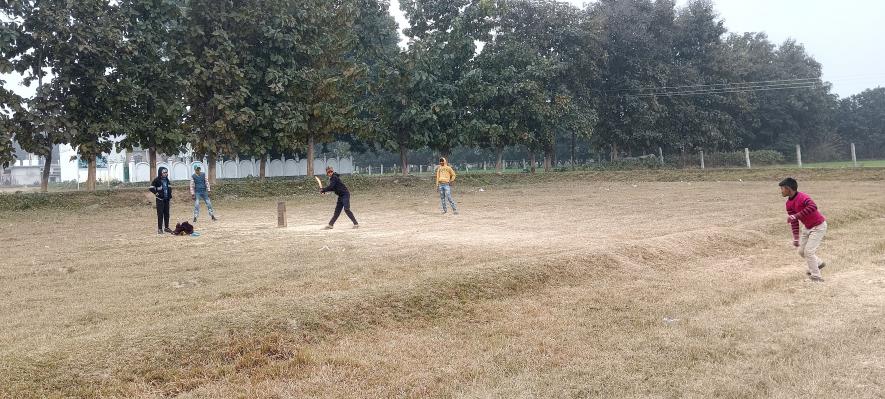
Highlighting the historical and cultural significance of the Awadh region, Athar further added, “The proposed land is in Awadh region where Ayodhya stands. In 1857, this district was major battleground against British rule, where Hindus and Muslims together fought the battle. Awadh has a shared legacy of Hindu-Muslim unity. Therefore, we want to send a message of unity from this project. Eventually, when you announce any project, one has to walk the talk, too. Last October, the chief of the foundation made some efforts and went to the financial capital, Mumbai. He met businessmen and asked for donation. For sure this project will happen, but we cannot provide the time and date.”
Notably, to pass the map from Ayodhya Development Authority, a NOC was sought from eight departments in 2020, including fire brigade, pollution control board and civic department. No department has given a NOC so far. Only when the fire brigade reached the spot to investigate the land, it was found that the width of the approach road to where the mosque is to be constructed was very narrow. At present, the width of the approach road is only 6 meters whereas it should be 12 meters. In such a situation, the fire brigade has refused to give NOC, a committee member told NewsClick.
No comments:
Post a Comment